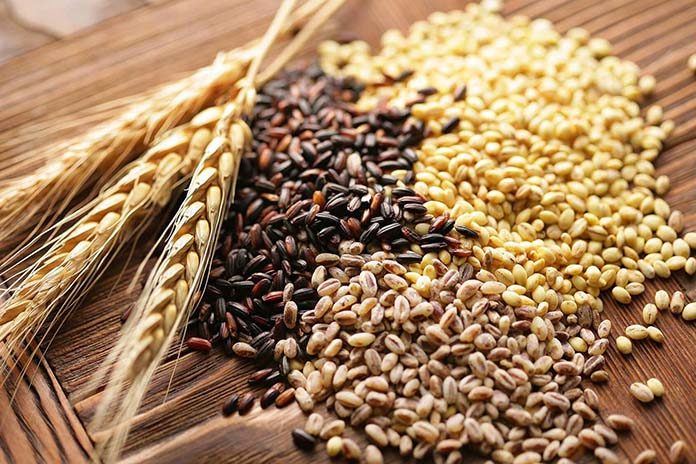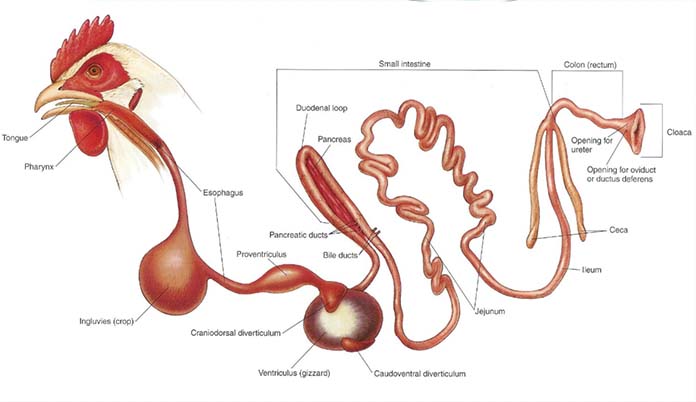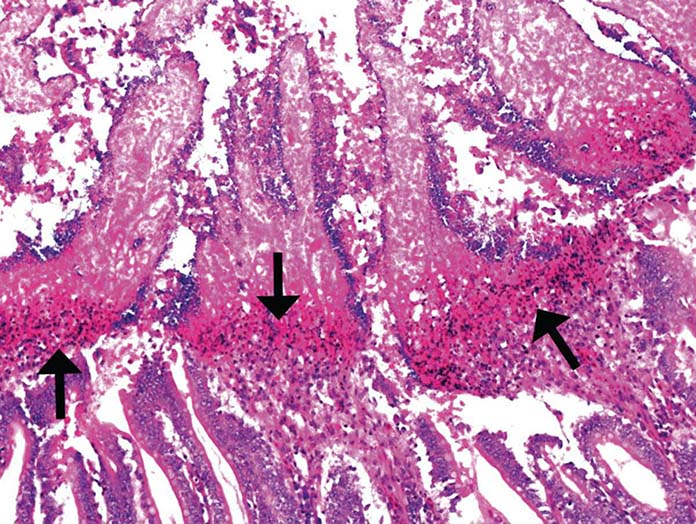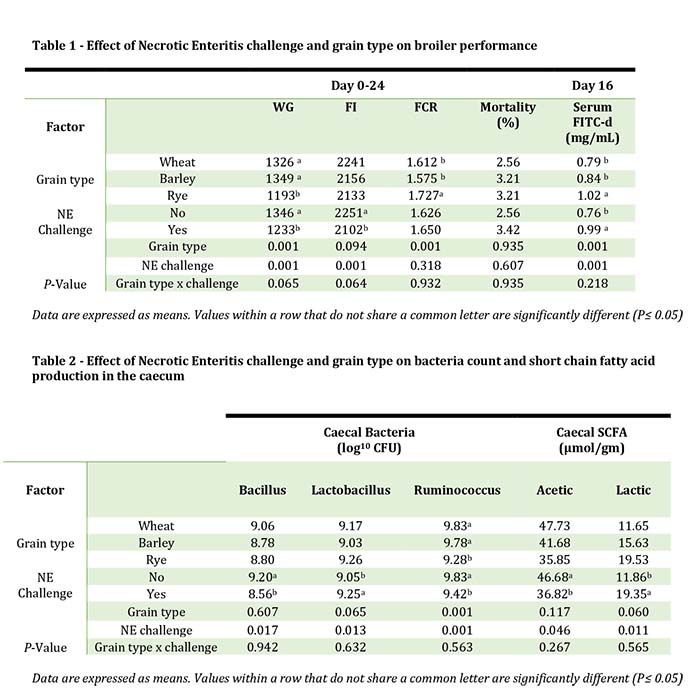
The aim of this study was to investigate the effect of grain type on performance and gut microbiota composition in broiler chickens under a necrotic enteritis (NE) challenge. Broilers were fed 3 different diets based on wheat, barley or rye, and were orally administered Eimeria and Clostridium perfringens to induce subclinical NE. The NE challenge significantly decreased weight gain, feed intake and counts of Bacillus and Ruminococcus bacteria in the caecal contents. Birds fed the rye based diets showed significantly reduced weight gain and feed conversion compared to the other diets. Rye fed birds also had the highest fluorescein isothiocyanate-dextran (FITC-d) marker in their serum and the lowest concentration of Ruminococcus bacteria and acetic acid in caecal contents. These findings suggest that grain type can directly influence the susceptibility and severity of NE challenge in broilers, largely through the impact of the non-starch polysaccharides (NSP) content of grain on nutrient availability, leaky gut, gut microbiota and short chain fatty acid composition. Necrotic enteritis (NE) is of great concern to the poultry industry due to its deteriorating impact on production and increasing mortality, resulting in a US$6 billion global economic loss. The causative agent of NE is Clostridium perfringens, a gram-positive spore-forming anaerobic bacterium.

The subclinical form of NE is financially more devastating than the clinical form. This is due to a lack of obvious symptoms resulting in a delayed instigation of an effective treatment, and consequently a substantial loss in flock performance and reduced feed efficiency. Feed composition strongly influences the gut environment and hence may impact the severity of NE. Cereal grains such as wheat, barley and rye contain high amounts of non-starch polysaccharides (NSP). Soluble NSP increase digesta viscosity and reduce digesta transit time. Insoluble NSP act as a nutrient diluent and create a physical barrier to enzymes, thus reducing starch, protein and lipid absorption and digestion. The purpose of the present study was to compare the impact of high NSP containing grains (wheat, barley and rye) on susceptibility of birds to subclinical necrotic enteritis. Performance, leaky gut, gut microbiota and short chain fatty acid composition of NE challenged broilers were evaluated in the different diet groups.
Material and methods
A total of 468 one-day-old male Ross 308 chicks were randomly assigned to 36 floor pens using a 2 x 3 factorial arrangement. The factors assessed were NE challenge (no or yes) and grain (wheat, barley or rye based diets). Total NSP (soluble and insoluble) content of wheat (9.29 g/kg), barley (10.73 g/kg) and rye (11.28 g/kg) was evaluated. To induce the NE challenge, birds were orally administered 1 mL Eimeria (5,000 oocysts) on d 9, followed by 1 mL C. perfringens (108 CFU) on d 14 and d 15. Birds and feed per pen were weighed on d 0 and d 24 to determine body weight gain (WG), feed intake (FI) and feed conversion ratio (FCR).
On d 16, two birds per pen were orally inoculated with FITC-d (4.17 mg/kg body weight) and serum samples were obtained 2.5 hours after inoculation, for leaky gut evaluation. The amount of FITC-d was measured by using a microplate reader (Synergy HT, Multi-mode microplate reader, BioTek Instruments, Inc., VT, USA). Caecal digesta samples were taken for bacteria enumeration by quantitative PCR and the method described by Jensen et al. (1995) was used for evaluating SCFA composition.

Results
The NE challenge significantly reduced FI (P = 0.001), and WG (P = 0.001) from d 0-24, irrespective of dietary treatment, but FCR was not affected (P = 0.318) by the challenge. Chickens fed with rye based diets showed a higher FCR (P = 0.001) and lower WG (P = 0.001). This group also had higher concentrations of FITC-d marker (P = 0.001) in their serum compared to those fed wheat or barley based diets. The NE challenge increased the FITC-d concentration (P < 0.001).There was no significant effect of the challenge on mortality rates. Additionally, no grain type by NE challenge interactions for performance or FITC-d was observed (Table 1). Table 2 shows that caecal Bacillus and Ruminococcus concentrations and acetate concentrations were decreased by the NE challenge (P<0.05, P = 0.001 and P<0.05, respectively). However, caecal Lactobacillus and lactic acid concentrations increased in challenged groups (P<0.05 and P<0.05, respectively). Rye diets decreased Ruminococcus population in the caeca, compared to wheat and barley diets (P = 0.001). There was no grain type by NE challenge interactions for any of bacteria or SCFAs investigated.
Discussion
High NSP contents can damage the gut through either thickening the digesta or causing dysbacteriosis in the lumen. Higher FITC-d levels observed in the rye diet fed chickens in the current study suggests that these diets had a more acute effect on the intestine tight junctions, causing a more severe leaky gut problem in the chickens. We also observed lower level of Ruminococcus bacteria in the caeca of birds fed with rye diets. The aforementioned bacteria are responsible for cellulose digestion, suggesting that lower performance observed in these birds could partially be due to lower polysaccharide fermentation in caeca. In addition, the lower level of Bacillus spp. and Ruminococcus observed in the NE challenged birds, could affect the acetate concentration due to lower degradation of starch and NSPs, which are the main sources for acetate production in the caecum. Fujiwara et al., (2009) reported that Bacillus spp. levels are associated with acetate concentrations in the caecum. Additionally, elevated lactic acid amounts in NE challenged birds have also been observed in other studies.
References are available on request
From the Proceedings of the 2018 Australian Poultry Science Symposium

















